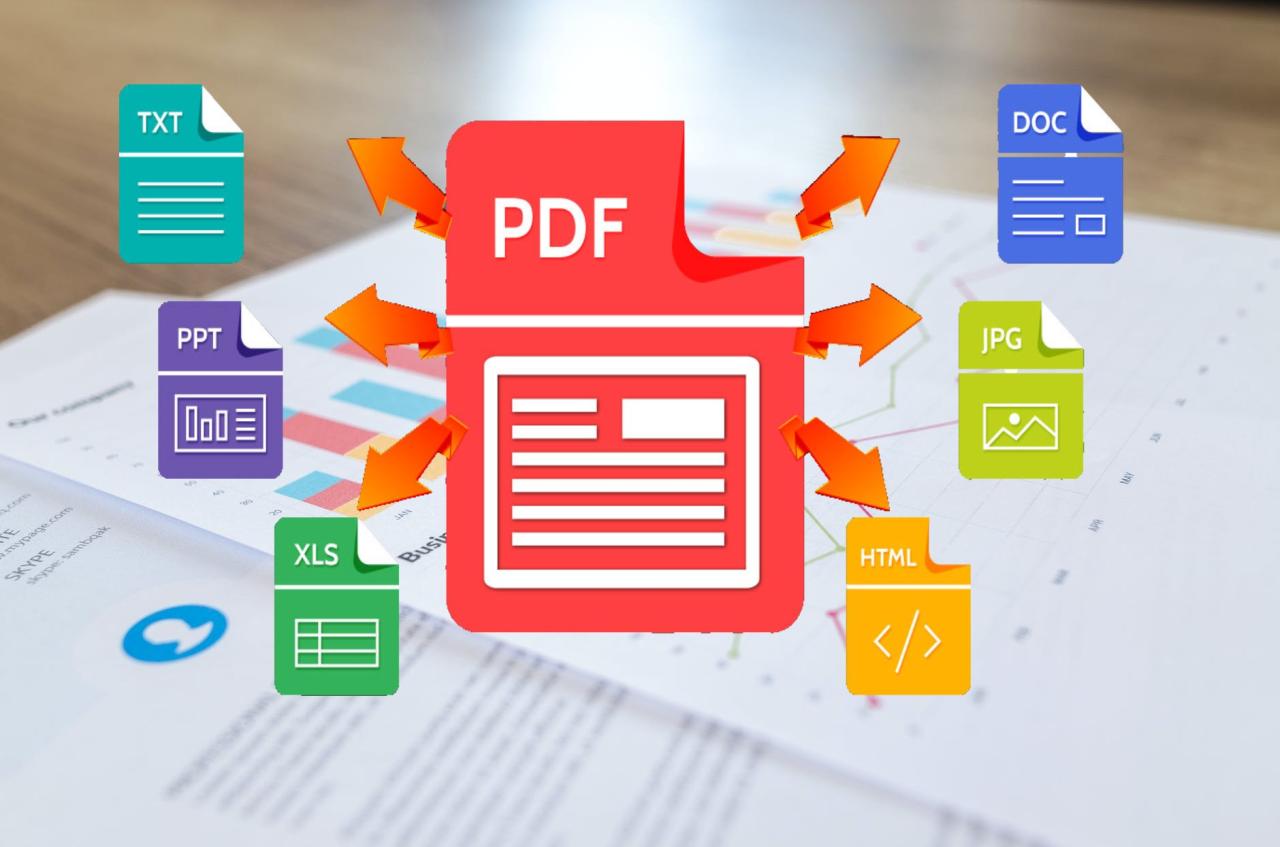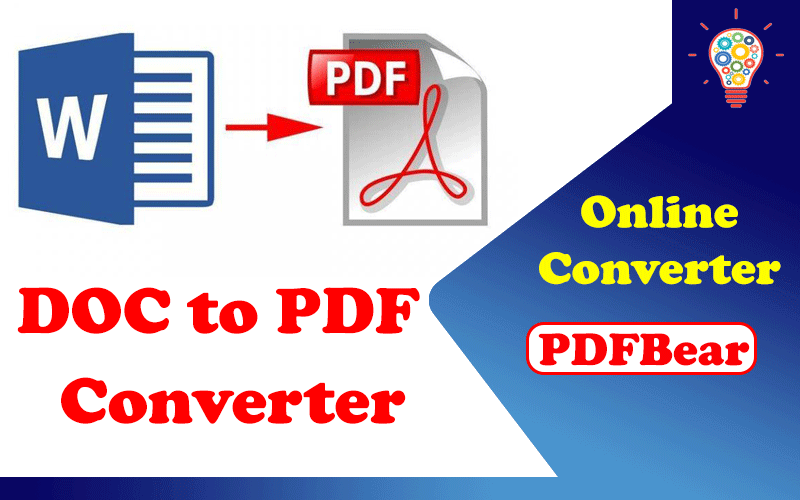Doc to PDF converter is a versatile tool that streamlines document sharing, archiving, and security. It allows users to convert Microsoft Word documents (DOC) into the universally compatible PDF format, ensuring consistent formatting across various platforms and devices.
Table of Contents
The conversion process involves transforming the layout, fonts, images, and other elements of a DOC file into a PDF, preserving the original document’s structure and appearance. This eliminates the risk of formatting changes or data loss when sharing or viewing documents on different operating systems or software versions.
Introduction to Doc to PDF Conversion

In today’s digital world, document sharing and collaboration are essential for businesses and individuals alike. While Microsoft Word’s DOC format is widely used for creating documents, the PDF format offers numerous advantages for sharing, archiving, and preserving document integrity. Converting DOC files to PDF ensures that the original formatting and content are maintained, making it a crucial step for seamless document distribution and long-term preservation.
Advantages of PDF Format
PDF, or Portable Document Format, is a widely adopted standard for document sharing and archiving due to its versatility and reliability. Here are some key advantages of using PDF for document distribution:
- Preserves Formatting: PDF files retain the original formatting of the source document, ensuring that fonts, images, and layout remain consistent across different devices and operating systems. This eliminates the risk of formatting inconsistencies or errors that can occur when opening documents in different applications.
- Cross-Platform Compatibility: PDFs can be viewed and printed on any device, regardless of the operating system or software installed. This universal compatibility makes it easy to share documents with colleagues, clients, or anyone else, without worrying about compatibility issues.
- Security Features: PDF files offer robust security features, including password protection, digital signatures, and encryption. These features help protect sensitive information from unauthorized access, ensuring document confidentiality and integrity.
- Archiving and Long-Term Preservation: PDF files are highly stable and can be easily archived for long-term storage. Their compact size and self-contained nature make them ideal for preserving documents for future reference or legal purposes.
Maintaining Document Formatting and Security
Converting a DOC file to PDF is essential for preserving the original formatting and ensuring document security. When you convert a DOC file to PDF, the following elements are retained:
- Fonts and Styles: PDF files preserve the original font styles, sizes, and formatting, ensuring that the document appears as intended on different devices. This is crucial for maintaining the visual consistency of documents, especially for reports, presentations, or publications.
- Images and Graphics: Images and graphics embedded in the DOC file are seamlessly incorporated into the PDF, maintaining their original quality and position within the document. This ensures that the visual elements of the document are displayed correctly, regardless of the viewing device.
- Page Layout and Structure: The page layout and structure of the DOC file are faithfully reproduced in the PDF, including margins, columns, and page breaks. This ensures that the document flow and readability are maintained, regardless of the platform or software used to view it.
Advanced Conversion Features
Beyond basic conversion, doc to PDF converters often include advanced features that enhance functionality and cater to specific user needs. These features can significantly improve document security, optimize file size, and streamline workflow.
Batch Conversion
Batch conversion allows you to convert multiple documents to PDF format simultaneously. This is especially useful for large projects or when you need to convert a large number of documents quickly.
- Efficiency: Instead of converting each document individually, you can select a folder containing multiple files and convert them all in one go. This saves time and effort, especially for large document sets.
- Organization: Batch conversion can help you organize your documents by converting them to a consistent format. This makes it easier to manage, share, and archive your files.
Password Protection
Password protection adds an extra layer of security to your PDF documents, limiting access to authorized users.
- Confidentiality: By setting a password, you can prevent unauthorized individuals from viewing or modifying the content of your PDF document. This is particularly important for sensitive documents containing confidential information, such as financial reports, legal documents, or personal data.
- Control: Password protection allows you to control who can access your documents. You can choose to restrict access to only specific individuals or groups by setting a password that only they know.
- Compliance: In some industries, password protection is required to meet regulatory compliance standards. This ensures that sensitive information is only accessible to authorized personnel.
Compression Options
Compression options reduce the file size of your PDF documents without compromising quality. This makes it easier to share, store, and download files.
- Storage Efficiency: Smaller file sizes require less storage space, which is beneficial for users with limited storage capacity or who need to store large numbers of documents.
- Faster Downloads: Smaller file sizes download faster, which is essential for users who need to access documents quickly or who have limited bandwidth.
- Email Compatibility: Some email providers have file size limits. Compression can help you reduce the file size of your PDF documents to ensure they can be sent via email.
Legal and Ethical Considerations
Converting documents from one format to another, including converting from DOC to PDF, can have legal and ethical implications, especially when dealing with sensitive information. This section delves into the legal and ethical considerations involved in document conversion, emphasizing the importance of respecting copyright and data privacy.
Copyright Considerations
Copyright law protects the original works of authors, including written documents. Converting a copyrighted document to PDF without the owner’s permission may infringe upon their copyright.
- Fair Use: The “fair use” doctrine allows for limited use of copyrighted material without permission for purposes such as criticism, commentary, news reporting, teaching, scholarship, and research. However, fair use is a complex legal concept, and it’s crucial to carefully evaluate whether your intended use qualifies as fair use.
- Permission: For any use beyond fair use, obtaining permission from the copyright holder is essential. This may involve contacting the author or publisher and seeking their explicit consent to convert the document to PDF.
Data Privacy Concerns
Document conversion can raise data privacy concerns, especially when dealing with sensitive information such as personal details, financial records, or medical information.
- Data Protection Laws: Data protection laws, such as the General Data Protection Regulation (GDPR) in the European Union and the California Consumer Privacy Act (CCPA) in the United States, regulate the collection, use, and disclosure of personal data. It’s essential to ensure that document conversion processes comply with these laws.
- Data Minimization: The principle of data minimization requires limiting the collection and processing of personal data to what is necessary for the specific purpose. When converting documents, it’s crucial to minimize the amount of personal data included in the PDF.
- Data Security: Protecting sensitive data during conversion is paramount. Implement appropriate security measures to prevent unauthorized access, use, or disclosure of personal information.
Best Practices for Compliance
To ensure compliance with legal and ethical considerations, adopt the following best practices:
- Understand Copyright Laws: Familiarize yourself with copyright laws in your jurisdiction and ensure your conversion activities comply with these regulations.
- Obtain Permission: If you intend to convert copyrighted documents, seek permission from the copyright holder.
- Respect Data Privacy: Prioritize data privacy by minimizing the inclusion of personal data in PDFs and implementing robust security measures to protect sensitive information.
- Use Reputable Conversion Tools: Choose conversion tools that are known for their security and privacy features.
- Review and Update Policies: Regularly review and update your policies and procedures related to document conversion to ensure ongoing compliance with legal and ethical standards.
Resources and Further Reading: Doc To Pdf Converter

This section provides a curated list of resources for further exploration of Doc to PDF conversion. It includes links to relevant websites, articles, and tutorials that can enhance your understanding of the topic.
Online Resources, Doc to pdf converter
This section provides a list of online resources for further exploration of Doc to PDF conversion. It includes links to relevant websites, articles, and tutorials that can enhance your understanding of the topic.
- Microsoft Office Support: Microsoft’s official website offers comprehensive documentation and support for converting Word documents to PDF. It provides detailed instructions and troubleshooting tips for various scenarios.
- Adobe Acrobat: Adobe Acrobat, a popular PDF editor, offers extensive resources and tutorials on creating and converting PDF documents. You can find detailed guides on converting Word files to PDF, including advanced features and settings.
- PDF Converter Websites: Numerous websites specialize in online PDF conversion. These platforms often provide free or paid services for converting documents from various formats, including Word, to PDF.
Articles and Tutorials
This section provides a list of articles and tutorials for further exploration of Doc to PDF conversion. These resources offer in-depth insights, practical tips, and best practices for converting Word documents to PDF.
- “How to Convert Word Documents to PDF: A Comprehensive Guide” (Website Name): This article provides a comprehensive guide to converting Word documents to PDF, covering various methods, features, and best practices.
- “5 Tips for Creating High-Quality PDFs from Word Documents” (Website Name): This tutorial focuses on creating high-quality PDFs from Word documents, emphasizing tips for optimizing formatting, images, and security settings.
- “The Ultimate Guide to PDF Conversion: A Step-by-Step Tutorial” (Website Name): This guide offers a detailed walkthrough of the PDF conversion process, covering various aspects from choosing the right method to optimizing the final PDF document.
Books and Publications
This section provides a list of books and publications for further exploration of Doc to PDF conversion. These resources offer in-depth knowledge, industry best practices, and advanced techniques for converting Word documents to PDF.
- “Mastering PDF Conversion: A Practical Guide for Professionals” (Author Name): This book provides a comprehensive overview of PDF conversion, covering various methods, techniques, and advanced features.
- “The Complete Guide to PDF: From Creation to Management” (Author Name): This book offers a comprehensive guide to PDF technology, including chapters on converting Word documents to PDF, optimizing PDF files, and managing PDF documents.
- “PDF Conversion for Beginners: A Step-by-Step Tutorial” (Author Name): This book provides a beginner-friendly introduction to PDF conversion, covering the basics of converting Word documents to PDF and essential tips for creating high-quality PDF documents.
Closing Summary
In conclusion, doc to PDF converters offer a seamless way to enhance document management, enabling efficient sharing, secure archiving, and reliable formatting. Whether you’re a professional sharing reports, a student submitting assignments, or an individual organizing personal files, the versatility of PDF format makes it an invaluable tool for modern communication and information management.
A doc to pdf converter is a handy tool for ensuring your documents are compatible across different platforms. If you don’t have Microsoft Word, you can download a free version here to create and edit your documents before converting them to PDF format.
Once you have your document ready, you can then easily convert it to PDF using a dedicated converter, ensuring it remains accessible and presentable regardless of the recipient’s software.
